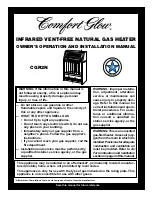
24
Service Procedure II:
Combustion System Testing and Replacement
Observe burner operation through the sight glass located on the combustion insert mounting flange. Normal burner
operation should ignite smoothly, without evidence of coughing or huffing upon ignition. The burner flame should be a blue
flame near the burner surface in a uniform flame pattern. Occasional yellow or white streaks are normal.
Note: On this high input model that uses metal fiber mesh burner a red glow from the burner surface is normal.
WARNING
120 volt potential exposure. Use
caution making voltage checks
to avoid personal injury.
N
Does the burner light
smoothly, without evidence of
coughing or huffing?
Check the air intake and venting
for obstructions or restrictions.
Check for obstruction at inlet of
gas valve. Is the inlet free of
obstruction?
Inspect the burner
tube (see Burner
Tube Inspection,
pg 27).
Does the burner stay lit?
Does the burner
operate normally until
thermostat is satisfied?
Call
Technical
Support.
System O.K.
Y
Y
Y
Y
Y
N
N
N
N
Y
Y
YY
N
Refer to control board illustration. Is
there 24VAC between
brown
and
blue
wires coming out of the control board
harness during the flame establishing
period? Digital display must show
“Heating” for operating status.
Check to see
brown
and
blue
wires are
properly connected to
molex connectors on
control board harness.
Does the gas valve energize?
Replace gas valve harness and/or
gas valve (see Gas Valve
Replacement Procedure, pg 29).
Clear the
obstruction.
Check flame sensor. Are there at
least 1-5 micro amps (min.) during
1.5 second flame proving period?
Value may be displayed on the
control display by accessing
Service Mode.
Inspect the burner tube. Replace the
flame sensor (see Flame Sensor
Replacement Procedure, pg 36).
Nat. Gas
Valve/Venturi
Y
Y
Y
N
Replace the
control board.
Make
connections.
N
Y
Inlet
Pressure
Tap
Continued from previous page.
N
24
Содержание EF120T4003N3
Страница 48: ......
















































